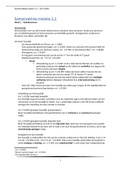College aantekeningen
Lectures Heart Failure and Therapy (VU Minor Biomedical Topics in Health Care)
- Instelling
- Vrije Universiteit Amsterdam (VU)
All the lectures of the course Heart Failure and Therapy, inlcuding notes. This course is part of the minor Biomedical Topics in Health Care, given at the VU university.
[Meer zien]









